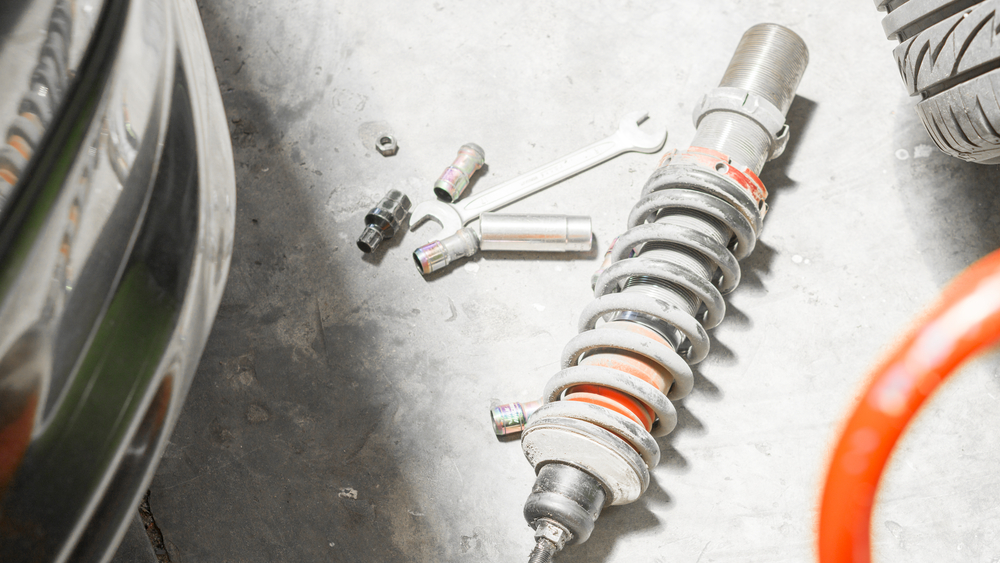When Should Shocks And Struts Be Replaced

The rhythmic thud of a well-maintained suspension is a symphony to the ears of any true car enthusiast. But like any critical component, shocks and struts degrade over time, turning that symphony into a cacophony of rattles and compromised handling. The question is, when do you know it's time to bite the bullet and replace them? The answer, as with most things automotive, is nuanced and depends heavily on your specific vehicle, driving style, and tolerance for discomfort.
The Obvious Signs (And Why You Shouldn't Ignore Them)
Before we dive into the specifics, let's address the glaringly obvious. These are the symptoms that scream, "Replace me now!"
- Excessive Bouncing: If your car resembles a lowrider after hitting a bump, you've got a problem. Multiple oscillations mean the shock absorbers are no longer absorbing anything.
- Nose Diving Under Braking: This is not only unnerving but downright dangerous. Excessive weight transfer forward drastically increases stopping distance.
- Body Roll in Corners: Feeling like you're piloting a boat through turns? Worn shocks contribute to excessive body roll, reducing grip and stability.
- Uneven Tire Wear: Cupping or scalloping patterns on your tires are a strong indicator of suspension issues, often stemming from bad shocks or struts.
- Fluid Leaks: Visible oil or fluid leaking from the shock or strut body is a definitive sign of failure.
Ignoring these signs not only compromises handling and ride quality but also puts undue stress on other suspension components, leading to a cascade of expensive repairs. Think of it as neglecting a toothache – it won't get better on its own, and it'll likely lead to more serious (and costly) dental work later.
Digging Deeper: Model, Engine, and Technology Considerations
While the above signs are universal, the rate at which shocks and struts wear varies significantly depending on several factors.
Model Specifics
A rugged truck designed for off-roading, like a Ford Raptor or a Jeep Wrangler Rubicon, will naturally require more frequent shock replacements than a meticulously maintained luxury sedan like a Lexus LS. Trucks endure harsher conditions and generally have more robust, but also more stressed, suspension components.
Engine Power & Weight
Consider a hypothetical scenario: Two Mazda Miatas. One equipped with the standard 2.0-liter engine and the other with a high-output turbocharged engine. The turbocharged Miata, with its increased power and potentially more aggressive driving style from its owner, will likely put more stress on the suspension, leading to faster shock wear. Heavier engines, regardless of vehicle, also contribute to faster wear.
Suspension Technology
Vehicles equipped with adaptive or electronically controlled suspension systems, like those found on some Audis and BMWs, present a unique challenge. While these systems offer superior ride quality and handling when functioning correctly, their complex components can be more susceptible to failure. Replacement parts are often significantly more expensive, and diagnostic procedures can be more involved.
Spec Table Example: Shock Replacement Intervals (General Guidelines)
| Vehicle Type | Typical Mileage Interval | Considerations |
|---|---|---|
| Passenger Cars (Sedans, Hatchbacks) | 50,000 - 75,000 miles | Driving style, road conditions |
| Trucks and SUVs (Light Duty) | 40,000 - 60,000 miles | Towing, off-road use |
| Trucks and SUVs (Heavy Duty) | 30,000 - 50,000 miles | Commercial use, heavy loads |
| Performance Cars | 30,000 - 50,000 miles | Track days, aggressive driving |
Real-World Driving Impressions and Subjective Factors
Beyond the objective signs and mileage guidelines, your own driving experience plays a crucial role. A subtle degradation in ride quality might be imperceptible to some drivers, while others will notice even the slightest decrease in damping performance. Consider these subjective indicators:
- Increased Road Noise: Worn shocks can transmit more road noise into the cabin.
- "Floaty" Feeling: A general lack of stability and control, especially at higher speeds.
- Harsh Ride Over Bumps: Less absorption of impacts, resulting in a jarring ride.
Ultimately, the decision to replace shocks and struts is a balancing act between objective data, subjective observations, and budget considerations. It's often wise to consult with a trusted mechanic for a thorough inspection.
Pros and Cons of Delaying Replacement
- Pros:
- Saving money in the short term.
- Avoiding the hassle of vehicle maintenance.
- Cons:
- Reduced handling and stability.
- Increased stopping distance.
- Uneven tire wear.
- Potential damage to other suspension components.
- Compromised safety.
In conclusion, replacing shocks and struts is an investment in your vehicle's performance, safety, and overall longevity. Don't wait for the obvious signs of failure. Be proactive, pay attention to your car's handling, and consult with a professional when in doubt. Your spine (and your tires) will thank you for it.
Disclaimer: These are general guidelines. Always consult your vehicle's owner's manual and a qualified mechanic for specific recommendations.
So, here's the debate starter: At what mileage should shocks and struts *always* be replaced, regardless of perceived condition? Let the arguments begin!
